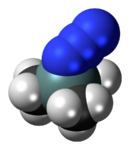Chemistry:Trimethylsilyl azide
From HandWiki
|
| |||
| Names | |||
|---|---|---|---|
| Preferred IUPAC name
Azidotri(methyl)silane | |||
| Identifiers | |||
3D model (JSmol)
|
|||
| 1903730 | |||
| ChemSpider | |||
| EC Number |
| ||
PubChem CID
|
|||
| |||
| |||
| Properties | |||
| C3H9N3Si | |||
| Molar mass | 115.211 g·mol−1 | ||
| Appearance | colorless liquid | ||
| Density | 0.8763 g/cm3 (20 °C) | ||
| Melting point | −95 °C (−139 °F; 178 K) | ||
| Boiling point | 52 to 53 °C (126 to 127 °F; 325 to 326 K) at 175 mmHg (92 to 95 °C at 760 mmHg) | ||
| reacts to form dangerous hydrazoic acid | |||
| Hazards | |||
| GHS pictograms |   
| ||
| GHS Signal word | Danger | ||
| H225, H301, H311, H331, H410 | |||
| P210, P233, P240, P241, P242, P243, P261, P264, P270, P271, P273, P280, P301+310, P302+352, P303+361+353, P304+340, P311, P312, P321, P322, P330, P361, P363, P370+378, P391 | |||
| NFPA 704 (fire diamond) | |||
| Flash point | 6 °C (43 °F; 279 K) | ||
| > 300 °C (572 °F; 573 K) | |||
Except where otherwise noted, data are given for materials in their standard state (at 25 °C [77 °F], 100 kPa). | |||
| Infobox references | |||
Tracking categories (test):
Trimethylsilyl azide is the organosilicon compound with the formula (CH
3)
3SiN
3. A colorless liquid, it is a reagent in organic chemistry, serving as the equivalent of hydrazoic acid.[1]
Preparation
Trimethylsilyl azide is commercially available. It may be prepared by the reaction of trimethylsilyl chloride and sodium azide:[2]
- (CH
3)
3Si–Cl + NaN
3 → (CH
3)
3Si–N
3 + NaCl
Reactions
The compound hydrolyzes to hydrazoic acid:[3]
- (CH
3)
3SiN
3 + H
2O → (CH
3)
3SiOH + HN
3
The compound adds to ketones and aldehydes to give the siloxy azides and subsequently tetrazoles:[1]
- (CH
3)
3SiN
3 + R
2CO → R
2C(N
3)OSi(CH
3)
3
It ring-opens epoxides to give azido alcohols.
It has been used in the Oseltamivir total synthesis.
Safety
Trimethylsilyl azide is incompatible with moisture, strong oxidizing agents, and strong acids. Azides are often explosive, as illustrated by their use in air bags.
References
- ↑ 1.0 1.1 Nishiyama, Kozaburo; Wang, Cheng; Lebel, Hélène (2016). "Azidotrimethylsilane". Encyclopedia of Reagents for Organic Synthesis. pp. 1–16. doi:10.1002/047084289X.ra117.pub3. ISBN 9780470842898.
- ↑ L. Birkofer and P. Wegner (1970). "Trimethylsilyl azide". Organic Syntheses 50: 107. doi:10.15227/orgsyn.050.0107.
- ↑ Jafarzadeh, Mohammad (2007). "Trimethylsilyl Azide (TMSN3): A Versatile Reagent in Organic Synthesis". Synlett 2007 (13): 2144–2145. doi:10.1055/s-2007-984895.
 |




